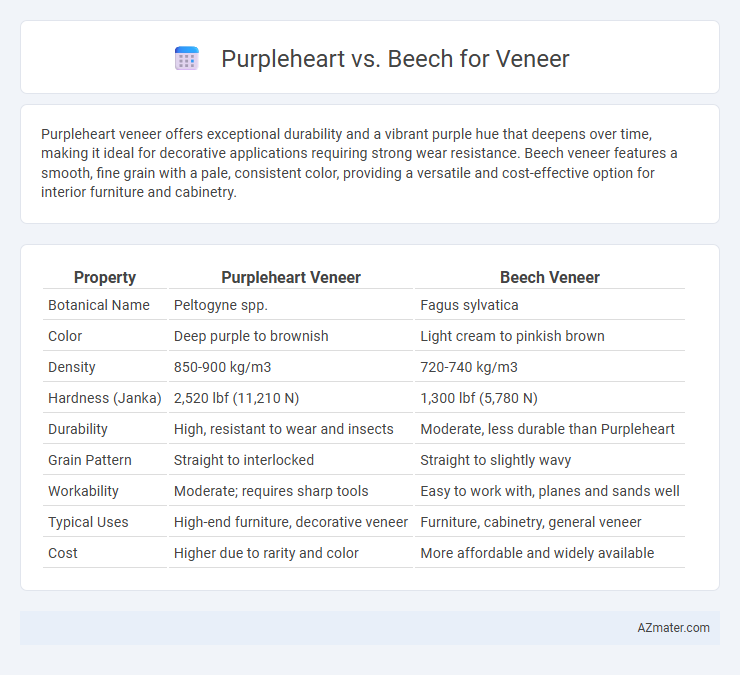Purpleheart veneer offers exceptional durability and a vibrant purple hue that deepens over time, making it ideal for decorative applications requiring strong wear resistance. Beech veneer features a smooth, fine grain with a pale, consistent color, providing a versatile and cost-effective option for interior furniture and cabinetry.
Table of Comparison
| Property | Purpleheart Veneer | Beech Veneer |
|---|---|---|
| Botanical Name | Peltogyne spp. | Fagus sylvatica |
| Color | Deep purple to brownish | Light cream to pinkish brown |
| Density | 850-900 kg/m3 | 720-740 kg/m3 |
| Hardness (Janka) | 2,520 lbf (11,210 N) | 1,300 lbf (5,780 N) |
| Durability | High, resistant to wear and insects | Moderate, less durable than Purpleheart |
| Grain Pattern | Straight to interlocked | Straight to slightly wavy |
| Workability | Moderate; requires sharp tools | Easy to work with, planes and sands well |
| Typical Uses | High-end furniture, decorative veneer | Furniture, cabinetry, general veneer |
| Cost | Higher due to rarity and color | More affordable and widely available |
Introduction to Purpleheart and Beech Veneer
Purpleheart veneer, derived from the Peltogyne genus native to Central and South America, is prized for its striking deep purple to brownish-purple color and remarkable durability, making it a popular choice for decorative woodworking and high-end furniture. Beech veneer, sourced from the Fagus genus widely found in Europe and North America, features a pale cream color with subtle reddish hues and a fine, uniform grain, known for its smooth texture and ease of finishing. Both veneers offer distinct aesthetic and functional qualities, with Purpleheart providing bold color and hardness, while Beech emphasizes lightness and versatile workability.
Botanical Origins and Distribution
Purpleheart veneer originates from the Peltogyne genus, primarily found in tropical rainforests of Central and South America, especially Brazil and Guyana. Beech veneer comes from the Fagus genus, predominantly distributed across temperate regions of Europe, North America, and parts of Asia. The distinct botanical origins influence the wood's texture, coloration, and durability, with Purpleheart known for its vibrant purple hue and Beech for its light, uniform grain.
Appearance and Color Differences
Purpleheart veneer features a striking deep purple hue that can range from reddish-purple to vibrant violet, often darkening over time with exposure to light. Beech veneer displays a much lighter and more neutral palette, including creamy beige tones with subtle pink or brown hues and fine, straight grain patterns. The distinct, bold coloration of Purpleheart contrasts sharply with the softer, more uniform appearance of Beech, making each wood choice suitable for different aesthetic applications in woodworking and furniture design.
Durability and Hardness Comparison
Purpleheart veneer demonstrates exceptional durability with a Janka hardness rating of 2,520, making it significantly harder and more wear-resistant than Beech veneer, which has a Janka hardness of approximately 1,300. This increased hardness of Purpleheart contributes to superior resistance against dents, scratches, and general wear in high-traffic areas or heavy-use furniture. Beech veneer, while moderately durable and more affordable, is better suited for applications where moderate hardness is sufficient and easier workability is desired.
Workability and Machining Properties
Purpleheart veneer offers superior durability with a dense, interlocked grain that resists splitting and chipping during machining, making it ideal for intricate detail work. Beech veneer provides excellent workability due to its fine, straight grain and uniform texture, allowing smooth cuts and easy sanding with minimal tearing. While Purpleheart requires sharper tools to handle its hardness, Beech is more forgiving during shaping and finishing processes, optimizing efficiency in veneer applications.
Sustainability and Environmental Impact
Purpleheart veneer is sourced from sustainably managed forests in Central and South America, known for its durability and resistance to decay, though its slower growth rate raises concerns about long-term availability. Beech veneer, primarily harvested from fast-growing European beech trees, offers a more renewable option due to its faster regeneration and widespread cultivation under sustainable forestry practices. Both veneers have relatively low environmental impacts when sourced responsibly, but beech's rapid growth and efficient carbon sequestration make it a more eco-friendly choice for sustainable woodworking.
Cost and Market Availability
Purpleheart veneer commands a higher price due to its rarity and vibrant purple hues, making it a premium choice for specialty woodworking projects. Beech veneer is more affordable and widely available, featured prominently in furniture and cabinetry markets for its uniform texture and light color. Market availability favors Beech, as it is sourced from fast-growing European and North American trees, while Purpleheart's tropical origin limits supply and increases cost.
Common Applications in Veneer Projects
Purpleheart veneer is prized for its rich, vibrant purple hue, making it ideal for decorative accents and high-end furniture in veneer projects. Beech veneer offers a light, uniform grain that enhances structural components and cabinetry, providing a neutral palette for various finishes. Both woods are favored for their durability and ease of sanding, but Purpleheart's unique coloration targets luxury designs, whereas Beech is preferred for consistent, clean aesthetics in commercial and residential applications.
Maintenance and Longevity
Purpleheart veneer exhibits superior durability and resistance to wear compared to Beech, making it ideal for high-traffic surfaces. Beech veneer requires more frequent sealing and refinishing to maintain its appearance due to its softer nature and greater susceptibility to moisture damage. With proper maintenance, Purpleheart maintains its rich color and structural integrity for decades, whereas Beech may show signs of aging and discoloration sooner.
Choosing the Right Veneer: Purpleheart or Beech?
Purpleheart veneer offers exceptional durability and striking deep purple hues that enhance luxury woodworking projects, while Beech veneer provides a light, uniform grain ideal for modern, clean aesthetics. Choosing between Purpleheart and Beech veneer depends on the desired visual impact and project requirements, with Purpleheart suited for bold, statement pieces and Beech optimal for subtle, versatile designs. Both veneers excel in stability, but Purpleheart's hardness exceeds Beech, making it preferable for surfaces subjected to heavy wear.

Infographic: Purpleheart vs Beech for Veneer
 azmater.com
azmater.com